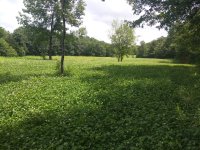As soon as I saw 35 acres and Bradford Pears, my first thoughts were: buy a new place or resort to napalm.

All joking aside I just got rid of the last couple Bradford Pear trees in my yard within the last fall and burned them (along with some other brush) last Friday (7/5/19). So I'd agree that mowing will prevent new trees from growing, but it doesn't prevent the stumps of collapsed old trees from sprouting new growth, as even grinding them down 4"-6" below the surface won't prevent them from sprouting new growth. Which is why with the last couple I rented a mini-excavator and dug the stumps out after cutting the trees down. The only reason I cut them down before digging was that the larger of the two was a 40ft tall tree that also had a 40ft spread just a few few above ground level. The smaller of the two wasn't much shorter, but it didn't have even half the spread, as it'd been regrowth of a previously cut/collapsed trunk.
Given these Bradfords don't sound quite as large as the ones I was removing I suspect it'd be even faster to remove them stumps and all and just be done with them. The two I dug out (the smaller being 12+ inches in diameter at the trunk) with a rented KX040 (a 5-ton mini-excavator that came with a hydraulic thumb) took less than 4 hours for the two of them. That time includes the learning curve of how to operate the machine. So a larger machine working on smaller trees would likely make very short work of a large area. While digging them out will make a mess initially, the collapsing of the rotted rootball will also leave a depression eventually. One of the Bradfords I'd previously removed from my yard I ground down 4"-6" below grade, and it eventually collapsed another 3"-4" (again a larger tree). So in a way it becomes a question of do you want to level things once, or multiple times in a given area? Additionally, based on what I've seen even if the trees don't have thorns now, if the stumps are permitted to resprout they may resprout bearing thorns.
Just me, but I'd consider sub-dividing the pasture into sections and then just tear out everything in a given section, then level and reseed it with the desired mix of grasses. Just as food for thought, while you're a bit further north than I am, I've replanted parts of my pasture in the fall (when its gotten back down to appropriate temperatures) and had the grass sprouting within a couple weeks with the horses having grass to graze on in other parts of the same pasture. Subdividing the pasture into sections should allow you to just focus on parts of the pasture at once to get a fresh start, and potentially set things up for controlled rotational grazing.
Obviously there are a lot of different ways to approach this, but based on my experiences with Bradford Pears I'd put some serious thought to just ripping them out by the roots and being done with them ... well, unless you're wanting/needing a virtually perpetual source of fast-growing biomass (that can occasionally be pretty if they haven't hybridized and acquired thorns). As much as I've grown to dislike Bradfords I would consider planting one or two just to have a reliable source of biomass to mulch and compost.
Unless there's something unusual, odds are the removal of the cedars will almost be an afterthought compared to the nuisance the Bradfords may turn into..... however, the cedars should dry relatively quickly and make burning the Bradfords even easier.

